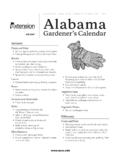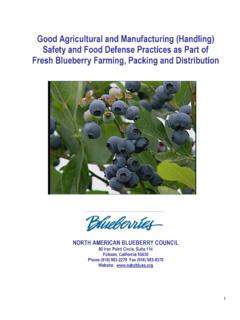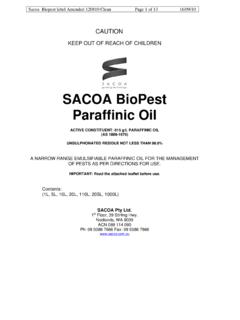Transcription of Guide To Growing Strawberries In Containers - Ken Muir
1 1 Guide To Growing Strawberries In Containers One of our medal winning exhibits using 'Self Watering Towerpots' at the Chelsea Flower Show displaying how effective and productive container Growing can be. Of all the popular summer fruits, Strawberries are one of the easiest to grow in Containers on the patio. container Growing is particularly advisable where ground space is limited, or where the soil or situation would otherwise prove to be unsatisfactory for the Growing of Strawberries . However, heavier yields per plant can be obtained at far less cost and effort by Growing the crop in the traditional way outdoors.
2 There are many different types of container available which vary considerably in shape, size, price and design. Basically any container will suffice so long as there is sufficient room for the roots and it has adequate drainage holes. Traditional terracotta pots are not to be recommended as they dry out very quickly and usually have very small planting holes. The best position for strawberry plants Growing in Containers is in full sunlight, but sheltered from the prevailing winds.
3 Large Containers should be stood upon bricks for drainage purposes and turned occasionally so that all the plants receive a share of sunlight. Planting Choosing the correct compost is fundamental to success. Disappointing results will follow from the use of unsatisfactory mixtures. The ideal compost is one that retains water and nutrients for a long period but does not become waterlogged through over-watering. For small to medium sized Containers such as Self-Watering Towerpots or hanging baskets best results will be obtained by using a John Innes compost or a good quality multi-purpose compost.
4 However, with large Containers better drainage will be 2 required. This is achieved by mixing the compost with vermiculite or perlite in the appropriate ratio. It is important that the compost mixture is moistened with a moderate amount of water before planting. When planting the base of the crown of the runner should be positioned at soil level with the roots hanging to their fullest extent without curling upwards. If the roots are too long for ease of planting, they may be shortened back to not less than 10cm (4in) in length, using a knife or pair of scissors.
5 It is important that the strawberry runners are planted at the correct depth; if the crown is buried or the roots left exposed, the plants will not thrive and may eventually die. A test for correct firmness is to attempt to gently pull a plant out of the soil by one of its leaves (or the crown of the plant in the case of coldstored runners). If the plant moves before the leaf tears, the planting has not been firm enough. The plants should be lightly sprinkled with water immediately after watering.
6 Watering Plants in Containers Overwatering is the most common cause of failure of strawberry plants grown in Containers . No hard and fast instructions can be given for watering because plants require very limited amounts of water when they are small, temperatures are low and under dull light conditions. Frequent watering is required when temperatures are high, the sun is shining, the plants are large and the fruits are swelling. Strawberry plants have a fine fibrous root system and for this reason will not survive for very long if they are allowed to grow in compost which is too wet.
7 More mature plants are better able to cope with this situation because they have a large root system and plenty of leaves to remove excess moisture but even they will die in time if this is allowed to carry on. Very young plants will be affected much more quickly because they are unable to remove excess water quickly enough. They should therefore be grown in a compost that is damp to begin with. The moisture content can be increased as the plants expand and the temperature rises but not to the extent of allowing the compost to become saturated.
8 Too frequent over- watering will also remove nutrients from the compost. A test to ascertain whether the compost is too wet is to take some in the hand and squeeze it. If the compost is saturated, any excess water will drain out between your fingers. If this happens then you will know that the compost is saturated and if allowed to continue the plants will die. The first sign of distress in the plants will be wilting of the foliage. The roots will be black in colour and such plants will not revive.
9 Do not allow the compost to dry out completely. If this should happen then it should be remoistened quickly, taking care not to saturate the compost. If the plants have already started flagging as a result of drying out, the Containers should be temporarily shaded, to allow the plants to recover. Feeding Plants in Containers The nutrients in fresh compost should be sufficient to provide satisfactory growth until the plants come into flower. At this stage, a liquid feed high in potash and low in nitrates ( The Ken Muir Strawberry Feed or tomato fertilizer) should be given once a week until the fruits start turning colour.
10 Like over-watering, the regular application of a fertilizer high in nitrates can adversely affect the cropping. Strawberries will crop best if they have the appearance of suffering from a slight deficiency of nitrogen resulting in the leaves having a pale green colour. A rather too yellow-green leaf colour is an indication that the plants need feeding. A compound fertilizer should be applied after the plants have finished fruiting, when the old foliage has been cut back.







